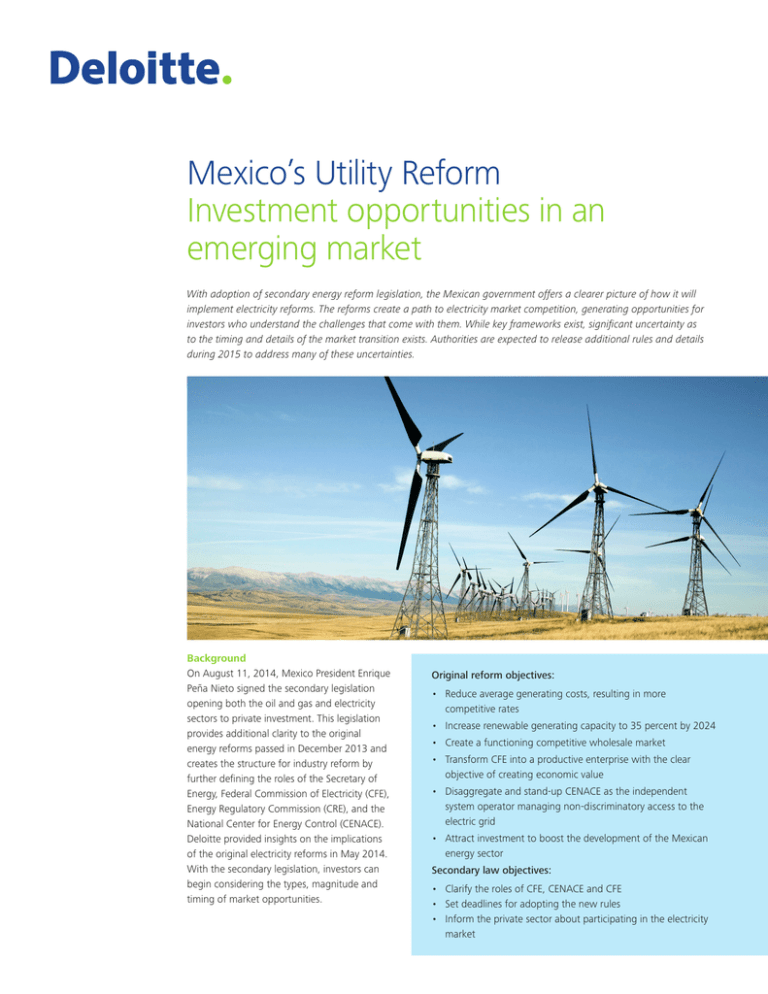Mexico`s Utility Reform Investment opportunities in an
advertisement

Mexico’s Utility Reform Investment opportunities in an emerging market With adoption of secondary energy reform legislation, the Mexican government offers a clearer picture of how it will implement electricity reforms. The reforms create a path to electricity market competition, generating opportunities for investors who understand the challenges that come with them. While key frameworks exist, significant uncertainty as to the timing and details of the market transition exists. Authorities are expected to release additional rules and details during 2015 to address many of these uncertainties. Background On August 11, 2014, Mexico President Enrique Peña Nieto signed the secondary legislation opening both the oil and gas and electricity sectors to private investment. This legislation provides additional clarity to the original energy reforms passed in December 2013 and creates the structure for industry reform by further defining the roles of the Secretary of Energy, Federal Commission of Electricity (CFE), Energy Regulatory Commission (CRE), and the National Center for Energy Control (CENACE). Deloitte provided insights on the implications of the original electricity reforms in May 2014. With the secondary legislation, investors can begin considering the types, magnitude and timing of market opportunities. Original reform objectives: • Reduce average generating costs, resulting in more competitive rates • Increase renewable generating capacity to 35 percent by 2024 • Create a functioning competitive wholesale market • Transform CFE into a productive enterprise with the clear objective of creating economic value • Disaggregate and stand-up CENACE as the independent system operator managing non-discriminatory access to the electric grid • Attract investment to boost the development of the Mexican energy sector Secondary law objectives: • Clarify the roles of CFE, CENACE and CFE • Set deadlines for adopting the new rules • Inform the private sector about participating in the electricity market New rules and new entities The electricity reform laws create rules for how the market will be conducted. As depicted in the chart below, several new entities have key roles: Source: Deloitte Consulting LLP • Generation—CRE will issue permits to new generators eligible to sell into a market. Governing the wholesale market, CENACE will determine qualified suppliers and the role of energy traders. • Transmission and distribution—CFE must split its Transmission and Distribution units into separate legal entities, and it may hire private companies to expand and enhance its transmission and distribution system. • Qualified, or retail, buyers—CRE will determine the minimum consumption levels for buyers to participate in the open market. High levels of consumption will mean only large commercial and industrial customers qualify. • Basic supply customers—This will include all non-qualified buyers, mostly residential, agricultural and small business customers. Regulators redefined The secondary laws provide additional clarity on the roles of the two regulators with the largest impact on the market— the Secretary of Energy and CRE: Secretary of Energy • Establish, conduct and coordinate energy policy • Verify compliance with the law • Direct the planning process and the development program for the electric sector • Ensure the coordination of regulatory entities and CENACE • Define requisites and criteria for clean energy certificates acquisition or assignment • Prepare and coordinate strategic infrastructure projects • Define obligations for electrical service coverage in poor communities • Authorize infrastructure programs for transmission and distribution • Define conditions for national content for contracts Energy Regulatory Commission (CRE) • Grant generation and transmission permits and establish their termination, modification or extension • Determine and apply rates for transmission, distribution, basic service, CENACE operations, and provider of last resort maximum rates • Issue electrical market rules and supervise their execution • Authorize contract models that are implemented by CENACE with generation, transmission and distribution companies • Grant clean energy certificates and validate compliance • Authorize the import of energy • Manage registration for qualified users and retailers 2 Risks and Opportunities These changes can create risks and opportunities. The changes will start in the wholesale and large account markets, which will represent the greatest investment opportunities. The retail market and the transmission and distribution system will also create opportunities for investors, though at a slower pace. The Wholesale Market—Opportunity and Uncertainty What’s new With more abundant, lower cost power to support economic growth and improved quality of life, companies can expect the market to evolve primarily on the wholesale and generation side through 2020. Market development will focus on new generation and asset replacement, with supporting infrastructure expansion, on a centrallyplanned, cost-based criteria. Significant market power will likely remain with the national utility, CFE. In parallel, we anticipate significant efforts to create a forward, pricebased market to go into effect no earlier than 2019. Who benefits New generation and asset replacement Current Mexican generation is diverse and high cost, with a heavy concentration of high-cost oil and diesel offset by low-cost hydro. The first phase of market restructuring will focus on increasing overall generation capacity significantly, from about 53-gigawatt (GW) to more than 70GW by 2020 and more than 90GW by 2030.1 Increased combined-cycle gas turbine (CCGT) generation and the gradual retirement of the inefficient oil and diesel plants, in particular, will provide downward pressure on electricity rates. Total investment is expected to exceed $60 billion dollars in the first decade, increasing to more than $100 billion by 2030. Solicitation rules have not been written yet, but a standard bidding process dictated by a state developed (CRE) generation resource plan is expected. Also expected— future legislation and rules that will clarify two key areas of the solicitation process: • The atypical separation of generation resource planning, done in CRE, from transmission capacity planning, done by CENACE. This separation can create inconsistencies in forecasts, making it difficult for the private sector to anticipate demand for generation and transmission capacity • The lack of explicit incentives for investment without a functioning price-based market may inhibit outside capital investment. International investors will expect Secretaria of Energia (SENER), Prospectiva del Sector Electrivo 2013– 2027, Page 136. 1 above-market returns to account for these market risks and uncertainties. CFE’s incumbent market power is a long-term issue of concern. We anticipate 4–8 ‘material’ generators to emerge, largely from current participants, with 2–3 discrete wholesale markets emerging. However, no plan has been proposed for mitigating this market power or divesting of CFE assets, which will make new entrants cautious. Gas infrastructure and renewables investment While meaningful gas infrastructure investment is occurring, investment—particularly for storage—likely will inhibit needed development of new CCGT capacity. New pipelines will enter Mexico from the north, incenting the concentration of new gas development in the northern states. Moving this power to load centers will require significant upgrades to existing north-south transmission lines and development of new east-west links. Consequently, developers will likely need to integrate both fuel and transmission infrastructure investments as part of any significant development deal. Meeting the mandated threshold for renewables—35 percent of total generation2—is likely to be a lower priority for investment, depending upon the level of government subsidies. Unlike most countries, Mexico will count hydro and nuclear toward its renewable mandates. Considering the significant renewable-qualified base today (renewables are currently 24 percent of generation), demand for renewables will be driven largely by growth. As a result, we expect total renewables generation to be about 12–15 GW through 2030. Direct incentives for renewable development are not part of the legislation. Instead, the rules call for Clean Energy Certificates (CEC’s) but the details have not been specified. CEC markets in general have not proven effective economically. However, the lingering high cost of existing generation could support renewables development. Wholesale market development The development of an underlying competitive wholesale market remains uncertain. The initial market opening, set for the end of 2015, is likely to consist primarily of establishing CENACE as an independent system operating entity outside of CFE (see chart below). Once the separation is completed, CENACE will focus on creating market-oriented capabilities. Senado de la Republica, Ruling of the United Commissions of Constitutional Points, December 2013, page 45. 2 3 Generation and Wholesale—Market Development The retail market What’s new Initially, retail competition will be limited to a subset of the largest commercial and industrial customers (qualified consumers) of over approximately .5 MW load. Minimum consumption levels to participate in the retail market will be set by the Secretary of Energy. As the market matures, minimum loads for participation will be lowered, increasing the portion of the market open to retail competition. We expect retail opening to be slow with no/little market expansion prior to 2020. Retail transactions initially will likely be commodity purchasers that are currently in a co-generation relationship. The supply to these commercial and industrial customers will come from generators looking to market uncommitted capacity. Brokerages are also likely to benefit for the next three to five years because of weak liquidity and poor transparency. This can change as market pricing signals mature in 2019. Source: Deloitte Consulting LLP Remaining questions and uncertainties While significant investment opportunities exist, many uncertainties and questions may affect investment attractiveness, including: • Long-term market power of CFE—will CFE divest of generation or split into a number of smaller generating companies? • Cost-based market—without a price-based wholesale market (or explicit incentives) will there be sufficient risk-adjusted return to meet generation development objectives? • Separation of generation from transmission planning— will this introduce uncertainties that inhibit generation development? • Economic and population shifts—what level of uncertainty is introduced by shifting load centers? • Development of market-oriented capabilities in CENACE—will the scope, pace and quality of its evolution ensure the successful, timely introduction of a viable market? • Viability of the renewable mandate—considering the positive emissions impact of new gas development, will CEC’s provide an effective incentive for development? From a practical standpoint, the market for the next three to five years will most likely be a new-capacity, open-bid market. The introduction of investment incentives for new generation development, the break-up of CFE’s market power and a clear road map for development of the market and CENACE are important issues that must be addressed soon. Customer billing is another area of uncertainty. At least until competition expands, Mexico is likely to avoid the problems experienced in the retail market in Texas. In that case, the system operator, the Electric Reliability Council of Texas (ERCOT), failed to create fundamental billing mechanisms, which eroded confidence in the transition to competition. In the near-term, system integrators may have opportunities to help CENACE and other entities create a digital infrastructure that underpins the wholesale and retail markets. Who benefits As it develops, the retail market is likely to create many investment opportunities including: • Brokerages and traders securing market share from industrial and large commercial customers are likely to gain strong positions that will endure and generate positive returns. • Co-generation developers • Non-qualified buyers initially will benefit from deregulation. Politicians, under pressure to show competition is reducing prices for all customers, are likely to extend subsidies. Over time, these can be reduced as the market matures. As subsidies decline, competitive offerings to utility-provided power may become viable depending on the delivered price of electricity. • Finally, the gas retail market will likely expand, though not quickly, as more infrastructure is completed. Over time, substitution may be a threat; but, it will be constrained by distribution infrastructure during the early years of competition, creating early opportunities in mid-stream gas investments. Remaining questions and uncertainties Key issues to be resolved include: • Expansion of Retail Access—how should choice move beyond large customers and what are the economics of doing so in the intermediate and long-term? • Financial impact on incumbent—how will lost revenue impact the core regulated business? • Transition from subsidies—will subsidies be able to stimulate retail choice? • Theft and uncollectable revenue mitigation—who bears the responsibility for collecting revenue that cannot be captured, both theft and non-payment? • Provider of last resort—does this role rest with CFE or does it get bid to alternative retail suppliers? • Tariff re-design—social and political impacts of unwinding rate subsidies? • Billing and customer service provision—what is CFE’s role/obligation? Does the role transition to others as the retail market matures? Transmission and Distribution What’s new The legislation mandates the disaggregation of the delivery business. Focus will be on expansion and modernization— specifically grid modernization, transmission interconnectivity and revenue integrity. Operations of the T&D network will be divided between CENANCE and CFE. CFE will continue to run the distribution network while CENACE and CFE will share the operation of the transmission grid with CENACE running the eight regional grid operations centers and CFE operating the more than 30 sub transmission areas within the eight regions. Additionally, CFE will have primary responsibility for efficient operation of the transmission and distribution systems in these sub areas, but it also must guarantee open access to generation providers. CFE’s transmission and distribution businesses will operate separately. Moreover, CFE’s distribution operations must be separated financially by region to compare performance. Who benefits Private transmission developers and contractors will be able to subcontract with CFE to support system expansion. Since 2004, the transmission system has grown annually by 1.4 percent, well below the 3 percent annual growth in electricity demand. CFE forecasts that the grid must expand by 17 percent annually through 2026 to keep pace with demand,3 making it likely to release public tenders Secretaria de Energia (SENER), Prospectiva del Sector Electrivo, 2013–2027, page 125. 3 to support the system expansion requirements. CFE will supervise the projects after coordinating with CENACE to determine where system expansion and upgrades are needed for generators. Remaining questions and uncertainties Key uncertainties and issues to be resolved in the delivery segments include: • Distribution break-up—to what extent, if at all, will the distribution monopoly be broken up into multiple operating companies and under ownership options? • Gas distribution expansion—what is the likely evolution of gas distribution expansion and the long-term impact on electric distribution? • Loss mitigation—magnitude of physical system deficiencies that drive high technical losses? • Tariff re-design—long-term rate structure and the potential of performance based rate designs? • Customer support—ability of the regulated entity to support ultimate interfaces with retailers/suppliers? • Grid modernization investment—timing and level of investment in grid modernization versus desire to maintain or reduce retail costs? • Subcontracting timeline—when will CFE begin subcontracting? • Local content rules—what percentage of work will be required to be performed by citizens and companies in Mexico? • Private sector—what opportunities exist for maintenance of the transmission system for the private sector? Closing thoughts for investors Mexico’s move toward a more market-oriented electricity system can create significant investment opportunities across the industry. Most outside investment will likely focus on the energy supply markets, while the attractiveness of the distribution and retail sectors will need further analysis. The development of the market will be a long journey from the existing regulated system to the market model envisioned in the reform legislation. To take advantage of the opportunity, investors should keep four things in mind: • First, they should monitor how initial competition is encouraged in the generation sector. This may take the form of incentives and support for investment in natural gas infrastructure or the mandatory divestment of CFE’s generation to mitigate market power. 5 • Second, they should monitor the development of the wholesale market and the evolution of CENACE. In particular, they should pay attention to the relationship between CRE and CENACE on system planning, timing, market development, and pricing mechanisms. • Third, they should follow activity in the commercial and industrial competitive supply market and the contractual terms of early deals. Authors: Antonio Damian Practice Leader, Mexico Power & Utilities Sector Principal Deloitte Consulting Mexico +52 55 50806134, ext. 6134 adamian@deloittemx.com • Finally, investors should monitor the actions of the President and the Secretary of Energy in their resolve to see that CFE becomes a productive enterprise. The stronger the resolve, the greater the opportunity for the private sector to provide support to CFE in modernizing its generation fleet, upgrading its grid infrastructure and improving everything from customer services to backoffice operations. James Hendrickson US Power & Utilities Sector Principal Deloitte Consulting LLP +1 404 631 2687 jhendrickson@deloitte.com Bob Wicke US Power & Utilities Sector Director Deloitte Consulting LLP +1 213 688 4710 rwicke@deloitte.com Special thanks to: Juan Vargas Grant Poeter Christian Grant Sanjib Chattopadhyay Pavan Krishnamurthy This publication contains general information only and Deloitte is not, by means of this publication, rendering accounting, business, financial, investment, legal, tax, or other professional advice or services. This publication is not a substitute for such professional advice or services, nor should it be used as a basis for any decision or action that may affect your business. Before making any decision or taking any action that may affect your business, you should consult a qualified professional advisor. Deloitte shall not be responsible for any loss sustained by any person who relies on this publication. About Deloitte Deloitte refers to one or more of Deloitte Touche Tohmatsu Limited, a UK private company limited by guarantee, and its network of member firms, each of which is a legally separate and independent entity http://www.deloitte.com/about. Please see www.deloitte.com/about for a detailed description of the legal structure of Deloitte Touche Tohmatsu Limited and its member firms. Please see www.deloitte.com/us/about for a detailed description of the legal structure of Deloitte LLP and its subsidiaries. Certain services may not be available to attest clients under the rules and regulations of public accounting. Copyright © 2015 Deloitte Development LLC. All rights reserved. Member of Deloitte Touche Tohmatsu Limited





